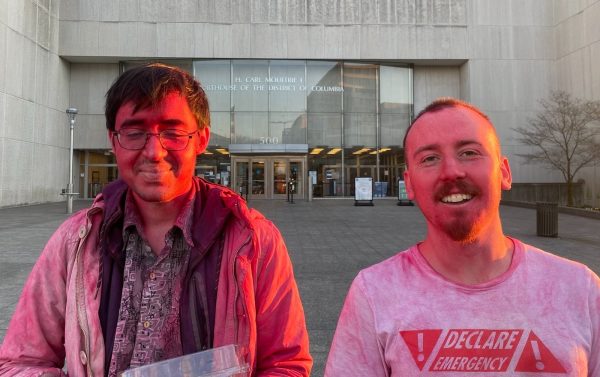Two climate protesters were arrested after pouring red dust on themselves and the encasement holding the original copy of the U.S. Constitution in the National Archives’ rotunda Feb. 14.
The protesters belong to Declare Emergency, a climate activist organization that practices public, nonviolent protest with the goal of prompting President Joe Biden to declare a climate emergency. According to a press release from the National Archives, security immediately evacuated the rotunda of the Archives following the incident and Washington, D.C. Metropolitan Police Department (MPD) officers arrested the two protestors.
Donald Zepeda, one of the protestors, said that declaring a climate emergency would allow President Biden to take direct, expansive executive action to address the climate crisis and create a sense of urgency around climate change.
“Declaring a climate emergency, if the president does that, unlocks abilities to advance a lot more clean energy, get more of that funded and invested in, and scale back on fossil fuel,” Zepeda told The Hoya. “Having the declaration also conveys to the public how bad it is.”
In a video of the demonstration posted to X, formerly known as Twitter, by documentarian Ford Fischer, Kroegeor Contrapip — the other of the two protesters — said he believes climate action is inherently linked to the rights the Constitution protects.
“This country is founded on the conditions that all men are created equally, endowed with the unalienable rights of life, liberty and the pursuit of happiness,” Contrapip said in the video. “We’re calling for all people to have these rights, not just wealthy white men. We all deserve clean air, water, food and a livable climate.”
Although the statement confirmed that the Constitution was unharmed, the rotunda remained closed for cleaning services and further evaluation of the damage Feb. 15 and 16.
Colleen Shogan, the archivist of the United States, condemned the demonstration and called for the protesters to receive the harshest legal penalty available.
“The National Archives Rotunda is the sanctuary for our nation’s founding documents,” Shogan wrote in a press release. “They are here for all Americans to view and understand the principles of our nation. We take such vandalism very seriously and we will insist that the perpetrators be prosecuted to the fullest extent of the law.”

(Declare Emergency)
Declare Emergency has previously led nonviolent protests in the Washington, D.C. area. Last April, the group blocked access to the George Washington Memorial Parkway and smeared paint on the glass case of Little Dancer, an Edgar Degas sculpture, at the National Gallery of Art.
Tim Martin, a mobilization coordinator at Declare Emergency, said that this type of provocative protest — inspired by the European climate organization A22, which has launched similar protests at London’s National Gallery, London’s Madame Tussauds and Museum Barberini in Potsdam, Germany — aims to forcefully seize the attention of leaders across both political parties.
Martin said that in addition to creating shock, he hopes that these demonstrations also yield real conversations around addressing climate change.
“What we learned from the Little Dancer action in April is that the news goes around the world,” Martin told The Hoya. “It’s as provocative as all the other A22 actions in Europe, except nobody’s talking about why we’re doing it. They give it a little bit of lip service.”
Despite backlash from the public and the authorities, Zepeda said Declare Emergency hopes to ramp up the scale and impact of their demonstrations as the climate crisis worsens.
Zepeda said that the more disruptive they can make their protests, the more effective they believe they will be in creating urgency around the changing climate.
“For a while now, I’ve kind of known that this sort of thing needs to be scaled up if we want to succeed at the scale and pace that we need to to address the climate emergency. There’s too much at risk with food shortages, droughts,” Zepeda said. “We need to act like we’re terrified, or else no one will believe that this is really as bad as it is.”








